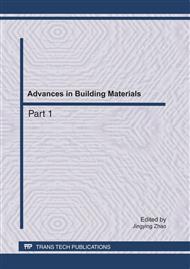p.371
p.376
p.380
p.385
p.389
p.394
p.398
p.402
p.407
Mechanics Properties of Concrete at Low Temperature
Abstract:
Mechanical properties at low temperature (-5°C, -20°C and -30°C) including compression strength, flexure strength, splitting tensile strength and modulus of elasticity of concrete with fly ash were investigated. In order to remain the temperature of the specimens unchanged during the test, a new insulation device was designed. In addition, the effects of curing ages on mechanical properties of concrete were studied. The results showed, at low temperature, all of the mechanical properties were improved; as the temperature decreases, the growth ratio increased continuously. The relative growth ratios of compression strength and flexure strength achieved the maximum value when the temperature decreased from -5°C to -20°C, and the relative growth ratios of splitting tensile strength and modulus of elasticity kept increasing during the whole process of cooling. At -35°C, all of the mechanical properties were improved at each curing age.
Info:
Periodical:
Pages:
389-393
Citation:
Online since:
May 2011
Authors:
Keywords:
Price:
Сopyright:
© 2011 Trans Tech Publications Ltd. All Rights Reserved
Share:
Citation:


